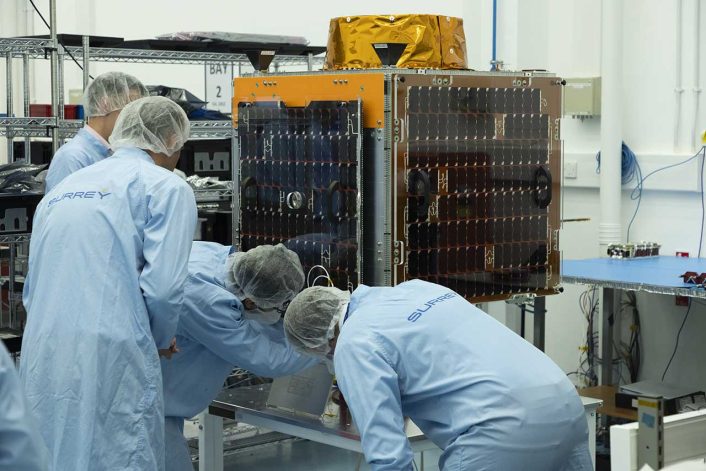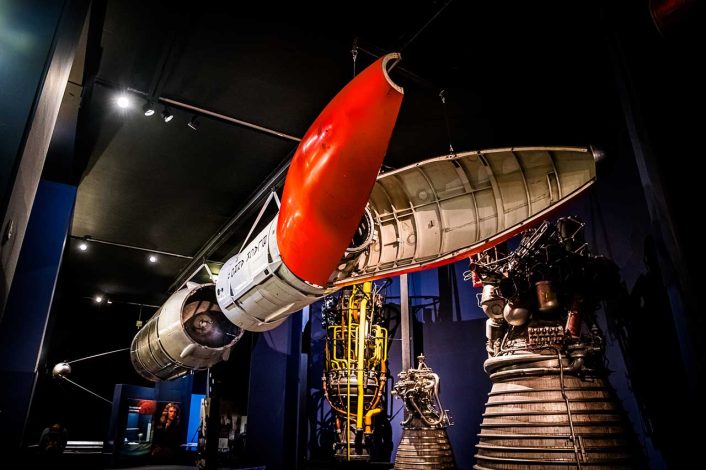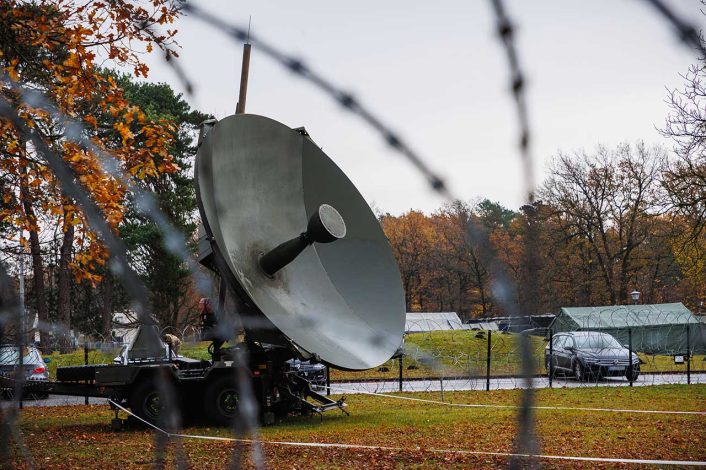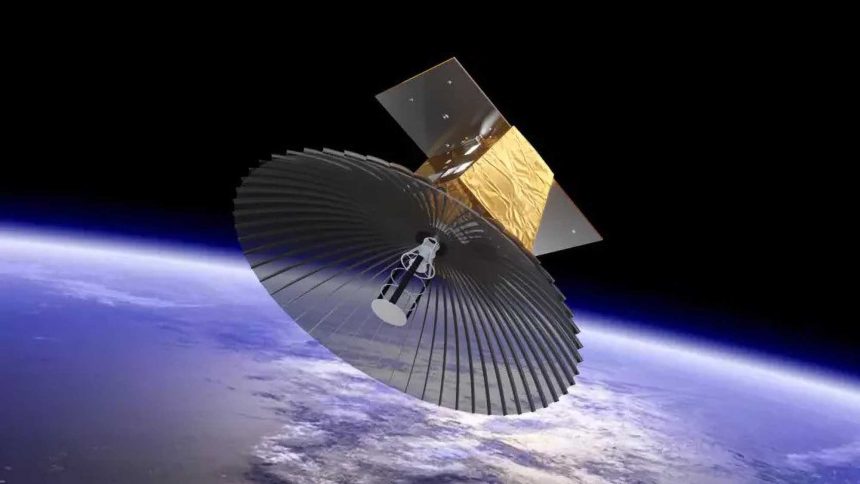A £127 million contract will see Airbus design and construct two synthetic aperture radar (SAR) satellites in the UK ready for launch in 2027.
Using high resolution synthetic aperture radar (SAR) imaging, the Oberon satellites will be able to operate in both day and night and in all weathers. The satellites will weigh approximately 400 kg, leveraging extensive experience by UK companies in constructing small satellites – such as the ‘wrapped rib’ antenna from Oxford Space Systems.
The Oberon satellites will join Tyche, the first satellite launched for UK Space Command since its formation in 2021, as part of the Ministry of Defence’s ISTARI programme. ISTARI will see a growing constellation of intelligence, surveillance, and reconnaissance (ISR) satellites deployed by UK Space Command by 2031.
Tyche is an optical imaging satellite manufactured by UK-based firm Surrey Satellite Technology Ltd (SSTL), which is wholly owned by Airbus Defence & Space. To mark the Oberon contract announcement, several images taken by Tyche were released. These included views of London Heathrow Airport, Washington D.C., Sydney, and, notably, the 2025 California wildfires.
Our armed forces will have access to the latest space-based imagery for military operations following a deal signed for a new satellite system, named Oberon.
The £127 million deal with @Airbus supports 200 skilled jobs, boosting the UK’s space capabilities.
📸 Tyche Satellite pic.twitter.com/ujySunbNaR
— Ministry of Defence 🇬🇧 (@DefenceHQ) February 10, 2025
Major General Paul Tedman CBE, the British Army officer who currently serves as UK Space Commander, spoke of the importance of space-based ISR: “Oberon, alongside Tyche and other satellites in our ISTARI constellation, will allow us to observe what’s happening on Earth from space at any time and through any weather. This will enable and enhance UK and allied military operations around the world.”.
Member of Parliament and Minister for Defence Procurement and Industry Maria Eagle added: “The contract for Oberon shows the UK’s commitment to grow one of the most innovative and attractive space economies in the world and keep our competitive edge in space science and technology.”.
It has not yet been announced which launch operator or vehicle the Oberon satellites will be carried into orbit by. The Tyche satellite was launched by a SpaceX Falcon 9 during a Transporter ‘rideshare’ mission, where the 150 kg satellite was carried alongside 115 others from a variety of nations and operators.

Also due to launch in 2027 is UK Space Command’s Juno optical imaging satellite, under construction by SSTL. Juno will build on the work already completed by Tyche. It is possible that Oberon and Juno could share launch vehicles in order to reduce costs, though it may be preferred to separate the payloads to reduce the impact of a potential vehicle failure.
Two MoD cubesats that were to be used for developing technology for the ISTARI programme were lost in January 2023 when their Virgin Orbit LauncherOne rocket failed to achieve orbit during a historic launch attempt from Spaceport Cornwall at Cornwall Newquay Airport, UK. Virgin Orbit never recovered from this launch failure, wrapping up operations in May of the same year and ending one of the avenues through which the UK hoped to attain a sovereign launch capability.
Oberon, Juno, and the communications satellite Titania reportedly due to launch in 2026, follow the example set by Tyche of using names inspired by Ancient Greek and Roman mythology. In the British military, Oberon had previously been used as the name for a class of highly successful Cold War era diesel electric submarines.
The UK’s Military Satellites
The UK has sought to make inroads into the sphere of military satellite operations since the very first days of man-made orbital objects, but has frequently had its ambitions quelled by the heavy financial burden incurred by even a small-scale programme. Modern innovations that allow satellites to be much smaller, cheaper, and for their launch to be much more cost effective, have seen a resurgence in these efforts.
An independent launch capability, Black Arrow, was developed during the 1960s, eventually placing the Prospero research satellite into orbit from a launch site in Australia in 1971. Prospero’s launch was Black Arrow’s first and only successful orbital launch – the programme was terminated several months prior to its launch, the launch only continuing as preparations were already well underway.

Britain’s first military satellite, Skynet 1A, was launched in 1969 on board a U.S. Delta M rocket. A communications satellite, it was the first military satellite of any nation to be placed in geostationary orbit. Though it only operated for a short period it proved itself as a capability the UK could not afford to ignore.
Skynet 2B, again launched on a Delta rocket, was the next successful Skynet communications satellite. Placed into a geostationary orbit above Africa, the satellite could be used from locations throughout Europe, the Middle East, and even into Asia. The Skynet 2 series were designed and built entirely within the UK, the first such satellites to be built outside of the United States and Soviet Union.
#OTD 30 August 1990, Ariane 4 flight #V38 launched with Skynet 4C and Eutelsat II F1 satellites… pic.twitter.com/sq2BNtqP7g
— European Space History (@ESA_History) August 30, 2018
Skipping Skynet 3 due to changing priorities, the next variant was Skynet 4 – its importance reinforced by a reliance on U.S. satellites (and political goodwill) during the Falklands War. A number of Skynet 4 satellites continue to operate today alongside the four current generation Skynet 5 satellites. Skynet 6A was originally intended to launch in 2025 aboard a Falcon 9, but this appears to have been pushed back to 2026.
The Skynet constellation offers an advanced, hardened global communications capability for the UK and allied armed forces across ultra high frequency (UHF), super high frequency (SHF), and extremely high frequency (EHF) bands.

During the 1980s, a significant effort was made by the British government to develop a sovereign signals intelligence (SIGINT) satellite. This highly secret endeavor was spearheaded by the Government Communications Headquarters (GCHQ), who, as a close partner of the U.S. National Security Agency (NSA) knew well the value of SIGINT satellites. Codenamed Zircon, the existence of this project became known to journalists who attempted to broadcast a documentary on the BBC revealing it to the world. This led to an extraordinary series of events involving police raids and extensive Parliamentary drama.
Zircon would have been launched under the guise of a new Skynet satellite, but was eventually cancelled in 1987 due to financial constraints, and as far as is publicly acknowledged nothing has ever taken its place. GCHQ continues to operate closely with its U.S. counterpart, playing a major part in the operation of U.S. owned satellites and the processing of data collected by them.
It is only in recent years, with the aforementioned reductions in cost, that an expanse in satellite operations has been seen as feasible. Despite having ditched its independent launch capability, the UK is a major player in satellite development and construction. The satellite industry in the UK is worth billions of pounds. Investment continues into ways of acquiring an independent launch capability – though geography remains a difficult hurdle, as most space launches launch to the East to take advantage of Earth’s orbit. Such launches from the UK would see rocket stages burning up over populated areas of Europe.
SaxaVord Spaceport on the Shetland Islands was awarded its launch licence in January 2025. Up to ten rockets will initially be permitted to launch from the site per year, with the first launch due in late 2025 or early 2026. Several customers have already been lined up by the site operators. Launches will be directed North to avoid mainland Europe, meaning it will primarily be launching satellites into polar orbits. SaxaVord is the second site granted a UK Spaceport licence after Spaceport Cornwall, but is the first to offer the facility for vertical launch to orbit rather than air-launch.









